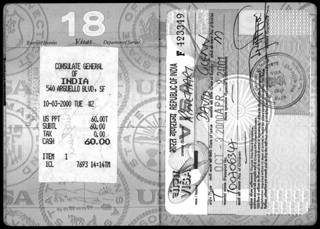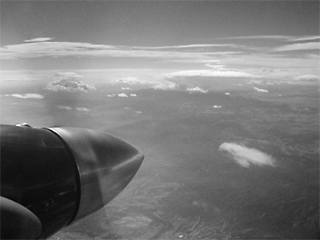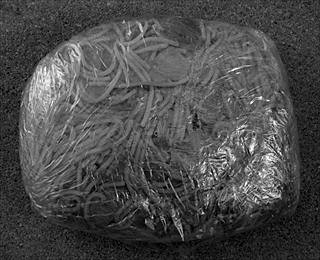| | - 29 September 2000
- Hoi Polloi Symphony
- Alison invited me to go to a San Francisco Symphony concert with her. I gladly agreed—after all, a free concert is a free concert—even though I’m not all that enamored with “classical” orchestral music.
It turns out that the performance was not only free for me, but for everyone else in the audience as well. There was a catch, of course. (Why is there always a catch?) The musicians didn’t perform in the symphony hall, they played on a temporary stage erected in an artificial San Francisco park. (Yerba Buena Gardens is a small mound of sod-covered earth piled on the roof of the city’s sprawling subterranean convention center.) Pacific Gas & Electric, the local utility monopoly, sponsored the event. I suppose the idea was to make those in attendance momentarily forget how much Piggy Greed & Extortion—as the firm is colloquially known here—overcharges its customers for execrable service. I had forgotten what a hundred unamplified musicians in starched white jackets and black bow ties sounded like, for better and for worse. I was impressed by the quality of the sound, except for one passage in which the violins played unaccompanied. They sounded rather shrill, and I involuntarily reached for the audio controls, which were some fifty meters away in the hands of Michael Tilson-Thomas. Grating violins notwithstanding, Tilson-Thomas did a good job at the controls. I especially appreciated his introduction to the Ravel piece that concluded the concert, “the ever-popular, haunting-slash-annoying Bolero.” Anyone who insults both sponsors and audience usually has my respect. I was amazed that I could clearly hear a solo flute over the din of nearby skyscraper construction, ambulance sirens, and low-flying jets leaving SFO. The San Francisco Symphony finally met its sonic match at 12:48, however; that’s when the bell ringer at St. Patricks cathedral started clanging the bells. And banging and bashing and smashing the bells. At first, the bells chimed slowly at regular intervals, as if prematurely announcing 13:00. After the perfunctory warmup, though, the bell ringer apparently decided s/he’d improvise and play along with the symphony. S/he banged the bells with no sense of pitch and in no apparent rhythm, thus sparing the audience from unadulterated classical pap. Somewhere, some bell ringer has “performed Ravel’s Bolero with the San Francisco Symphony” on his or her résumé, and I’m glad s/he does. 
- 30 September 2000
- An Unencumbered Burrito
- When Luis asked me if I’d like to see Nao Bustamante’s Wax Museum show, I replied, “Who?”
Luis explained that Bustamante is a “performance” artist, who is perhaps best known for her 1992 piece, Indigurrito. Luis showed me a press clipping. “She literally presents an endearingly funky wax museum-style effigy of herself as a big-hair Latino dominatrix,” the reviewer enthused, then added “... she donned a strap-on burrito to help straight white guys appease their liberal guilt through a ritual nibbling of the tortilla.” Say what?! I am confused. Although I am a straight, liberal, white guy, I am not guilty (if only because I’ve never been caught and convicted). And even if I was guilty, how would my guilt be appeased by eating a burrito attached to the lower abdomen of a woman in a ridiculous outfit? What kind of burrito does she offer? (When I’m in San Francisco, I have the luxury of being very selective about what burritos I eat.) And, most importantly, how would I get the salsa to stay on a horizontal burrito? On most days, I agree with Carranza’s postulate, “The burrito is the foundation for a salsa banquet, nothing more, nothing less.” I declined Luis’s kind invitation, and instead went to El Toro Tacqueria to enjoy a fine burrito—black beans and rice on a spinach(!) tortilla—unencumbered with any burdens except five difference kinds of thick and very spicy salsa. 
- 1 October 2000
- Spinning My Own Entrails
- Sean Connolly of Industrial City, New Jersey, recently sent a note expressing his appreciation of my artist’s notebook of sorts. He also said he hoped that I would “appreciate other insights into the nature of notebooks,” and thoughtfully provided several examples:
A man who keeps a diary pays,
Due toll to many tedious days;
But life becomes eventful—then,
His busy hand forgets the pen.
Most books, indeed, are records less
Of fullness than of emptiness.
—William AllinghamI think this journal will be disadvantageous for me, for I spend my time now like a spider spinning my own entrails.
—Mary Bokin Chesnut What the Journal posits is not the tragic question, the Madman’s question: ‘Who am I?,’ but the comic question, the Bewildered Man’s question: ‘Am I?’ A comic—a comedian, that’s what the Journal keeper is.
—Roland Barthes “I do not keep a diary. Never have. To write a diary every day is like returning to one’s own vomit.”
—Enoch Powell
- What a way to start the month. I will never ever buy a drink for Sean Connolly of Industrial City, New Jersey.

- 2 October 2000
- Bound for India
- I’ve just accepted an offer from a beautiful and mysterious woman to join her on a three-week trip to India. Even though there’s no female of the opposite sex I find more attractive, it took me a while before I finally accepted her offer.
Friends who’ve been there all advised me to go, but I wasn’t so sure. I dislike hot climates and have been spoiled by first-world creature comforts. There was also the matter of time. The three-week trip to India is immediately followed by the three weeks around the end of the year when nothing ever gets accomplished. I finally agreed to go when the beautiful and mysterious woman pointed out that six weeks of doing nothing is almost irrelevant in that I often go months on end without doing anything at all. I couldn’t refute that argument, especially on Mohandas Karamchand Gandi’s one hundred and thirty-first birthday. I’m going. As long as I’m being indolent, I may as well do so in a place where the overhead is low. 

- 3 October 2000
- The Rajputs’ Wisdom
- I’m in the India Consulate, where I’m getting a taste of India (not to be confused with the restaurant of the same name). It’s 92 percent Indians, seven percent white hippie chicks (who are using the word “karma” with alarming frequency), and me. There’s an Indian soap opera on the telly (traumatic singing, wild dancing, and melodrama galore), the toilet smells bad, my fellow detainees are friendly, and my computer refuses to work.
After waiting in line for an hour and a half to buy a sixty-dollar visa (which last week used to be a fifty-dollar visa), the surly—and only—clerk told me I’d have to return at the end of the day to pick up my passport. I returned to the India Consulate a few hours later, as did most of the other hundred and sixty-one people who’d visited the consulate earlier in the day. I joined the long line to the one and only open window, which turned out to be one of several competing lines. Even though none of the consulate’s apparatchiks ventured out of their secure offices to bring order to the chaos, everyone in line(s) was surprisingly good-natured in spite of the heat and humidity inside the cramped reception area. “The rajputs have disorganized this event for your ultimate satisfaction,” a young Indian man waiting in line cheerfully explained. “You see, there is no point at all, no point whatsoever, in visiting the Republic of India if you do not really want to visit the Republic of India. Bombay is not Berlin, and Delhi has but few similarities with Detroit. If you know this in advance, as you surely will after today’s rich experiences, then you will not be unduly surprised upon your arrival.” “Or,” he added with an enigmatic smile, “perhaps you will.” We’ll see. 

- 4 October 2000
- Really Flying
- I’m enjoying a flight from Denver to Santa Fe on a real airplane. It flies with propellers that I can understand, not with jet engines that make no sense at all to me, even after dozens of explanations. When we hit a cloud in this little plane, it shudders a tiny bit, exactly as an airplane should. Every time I’m in a mammoth jet that flies into a cloud with no physical reaction, I always feel like I’m looking out the window at an expensive holographic projection.
This little plane has ten rows of seats, with one seat on either side of the narrow aisle that runs the length of the short fuselage. The cockpit has no door, so I could lean into the aisle and watch the takeoff. I can also watch the pilots during the flight, and find out what they do between takeoff and landing. Our copilot appears to be devoting most of her time to admiring her manicured fingernails, but, since I suppose it’s against all sorts of laws and regulations to read a good book while flying passengers around, I guess that’s about all she really can do. Because of the intimate seating pattern, I can’t help but overhear the conversation the middle-aged man in front of me is having with the young woman across the aisle from me. The man says he’s returning from his father’s funeral in Imperial, Nebraska. The woman says she’s sorry, which of course is practically the only thing one can respond to a stranger in that situation. The man explains that she needn’t be sorry, because his father had a full and healthy life until just a few weeks before he died. He adds that his ninety-year old mother is still well, “gardening and canning and doing all the things people in Nebraska do.” The woman describes her home in Portland, Maine, and how she takes frequent ferry trips to visit her relatives in Nova Scotia. “There’s a ferry from Portland to Nova Scotia?!” the man exclaims. “I must take that trip before I get much older.” There’s nothing like a funeral to put things in perspective. Things, and time. 
- 5 October 2000
- Meaningless Words
- Many words convey meaning, but not these.


- 6 October 2000
- Guest Improvisations
- I enjoy staying in friends’ homes, and my Santa Fe visit is no exception. Being in a strange house is always delightfully disconcerting; I can never spend very much time on autopilot. This afternoon, for example, I was pleasantly flummoxed when I couldn’t find a container for the leftover pasta. The only solution I could discover was to wrap the pasta, tomatoes, onions, mushrooms, olives, and garlic in several layers of plastic wrap. In doing so, I accidentally created a sculpture.
I don’t think I could have invented a pasta balloon in my laboratory, even if I tried. I thrive on changing scenery. 
- 7 October 2000
- Stravinsky Rules
- I’m watching the Santa Fe Symphony rehearse Igor Fyodorovich Stravinsky’s The Rite of Spring. The selection of music seems wrong wrong wrong in that the season outside is autumn, the anti-spring if ever there was one.
It’s been so long since I’ve been in an orchestra that I forgot what a real tuba looks like. (I’m embarrassed to report that I was expecting to see a Sousaphone.) I’m nevertheless enjoying the experience, even though it hurts to listen to the Infernal Dance segment. My lips grimace every time they hear the horns hit the high notes that caused them so much pain decades ago. What a spectacle! Before me, I see dozens of people slavishly carrying out a dead man’s written instructions. I can see that a large percentage of the musicians weren’t even conceived when Igor died. I’m amazed to watch the old genius literally pulling strings from the grave. I can’t think of a visual art corollary, although that will change if Sol LeWitt dies before I do. 
last transition | index | next transition
©2000 David Glenn Rinehart
| |

